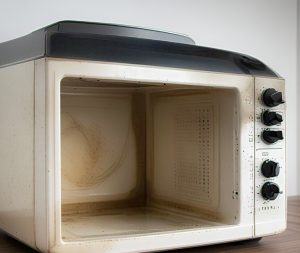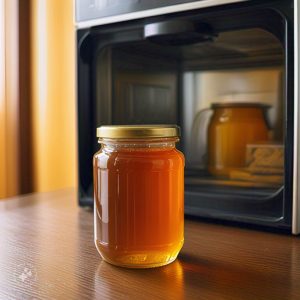Mold is a type of fungus that can grow in various conditions, including damp and warm places such as microwaves.
The question here is whether mold can indeed develop inside a microwave oven or not.
In this article, we will delve into the circumstances that might lead to the growth of mold in your microwave, and if it’s a possibility. We’ll look at whether you can prevent it from happening or ways to clean and eliminate any existing mold. Furthermore, we will explore tips on how to maintain your microwave to keep it free from mold growth. To cover all bases, frequently asked questions regarding this topic will be answered as well.

Jump To:
Can Mold Grow in a Microwave?
Yes, mold can indeed grow in a microwave if the conditions are right. Microwaves are typically humid and warm after use, which provides an excellent environment for mold to thrive. However, frequent cleaning and proper ventilation can prevent these microscopic fungi from spreading. For instance, leaving the door open after usage allows moisture to evaporate instead of condensing on surfaces within the appliance. Also ensuring that no food particles are left behind further denies mold its necessary nutrients, thus inhibiting growth.
Check out if mice can get into microwaves.
Facts About Mold Growth in Microwaves
Here we will discuss the important things to note about mold growth in microwaves.
- Environment: Molds thrive in warm, humid, and dark environments – conditions that a microwave can provide if not cleaned regularly.
- Nutrient Source: Leftover food particles or spills inside the microwave serve as a nutrient source for molds.
- Growth Speed: Depending on the conditions, mold can start growing within 24-48 hours.
- Type of Molds: The most common types of mold found in microwaves are Cladosporium, Penicillium, Aspergillus and Alternaria.
- Danger: Some molds produce mycotoxins which could pose health risks when ingested or inhaled. It’s necessary to clean your microwave regularly to prevent this risk.
To conclude this section about mold growth inside microwaves; it is crucially important not only for maintaining hygiene but also preventing potential health hazards.
Now, let’s move onto discussing other aspects of using a microwave safely and efficiently.
What are the Alternatives to Microwaving Mold?
The alternatives to microwaving mold include using natural sunlight, vinegar or bleach solutions. These methods can be quite effective in eliminating mold. For instance, exposing moldy items to direct sunlight for several hours can kill the fungus. Similarly, a mixture of vinegar and water sprayed onto the affected surface and rinsed after an hour can work wonders. Finally, bleaching is another potent method where one part bleach is mixed with ten parts water and applied on the molded area.
Check out if microwaves can kill bacteria.
Tips to Microwave a Mould-Infected Item
To ensure safety while microwaving a mouldy item following tips should be kept in mind:
- Clean your microwave thoroughly before use.
- Avoid heating the food if you suspect it’s contaminated with mould.
- If you must heat such food, cover it properly so spores don’t spread.
- Monitor continuously while heating as some materials might get damaged due to excessive heat exposure.
- Last but not least, discard any leftover food immediately post cooking.
In summary, we’ve covered alternatives to microwaving mold along with key considerations when doing so.
Check out if you can clean your microwave with bleach.
Let’s now move forward discussing some frequently asked questions regarding this topic.

Frequently Asked Questions (FAQs)
In this section, we will now look at the most commonly asked questions related to microwaving and heating.
Can mold grow in a microwave?
Yes, mold can grow in a microwave if it’s not cleaned regularly. The presence of food particles and moisture creates a conducive environment for mold growth. It’s crucial to clean your microwave frequently using anti-bacterial solutions or vinegar-water mixture to prevent this issue.
Does heating food in a microwave kill bacteria?
Heating food in a microwave can kill bacteria, but only when done correctly. The heat should be evenly distributed throughout the food item; otherwise, some bacteria may survive. Use stirring techniques and cover dishes with microwave-safe lids for effective heating.
Can you reheat takeaway containers in a microwave?
No, you cannot reheat takeaway containers directly in the microwave as they may contain harmful chemicals that can leach into your food when subjected to intense heat from the appliance. Instead transfer the contents into a microwave-safe container before reheating.
What happens if you run an empty microwave?
If you run an empty microwave, it could potentially lead to damage of its internal components due to lack of heat-absorbing elements inside it during operation. This often causes excessive energy buildup which is harmful for the appliance.
We hope these answers give you added clarity on some important aspects related to microwaving and heating!
Final Word
To conclude, proper use and regular maintenance are essential factors to ensure safe microwaving practices. Microwaves offer great convenience but incorrect usage or neglecting cleaning sessions might invite problems like mold growth or even equipment damage! So make sure to follow the guidance for your safety and appliance longevity.



